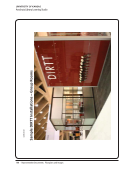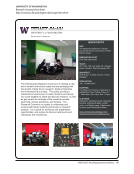SPEC Kit 327: Reconfiguring Service Delivery · 23
Environment). Their first project in 2009 was the Library Video Niche, the redesign of a corner of the Fine Arts Library
Great Room to display video art. This project, funded by a UVA Arts Council grant, was quite successful both inside UVA
and outside with a greater audience. Last year in 2010, Fine Arts converted an unused office space into the EyeLab,
a collaborative work space featuring two LCD screens and a smart overlay. The space is available for online bookings
and it stays filled. They have also “recycled” their former Slide Collection space into a ScanLab with high-end Macs and
scanners. Their current year project for 2011 in the ScanLab is creating a lounge area for group work and visual display
as well as a space for informal lectures using digital technology. This space will include comfortable seating for more
people as well as providing a large LCD screen display for public access. The Digital Media Lab has added an AV studio
as a staffed service point in the past two years. The main library reduced the physical size of the Reference Desk and
reduced professional librarian staffing at the desk from two to one. The second librarian now works the shift from his/
her office to concentrate on virtual reference (chat, SMS, and email). A staffed service point in the science/engineering
library, the Research Computing Lab, was closed. Student employees were not rehired at the end of the semester and
the staff are now working in a different group. The Education Library was reconfigured as a commons area for the
Education School.
The following changes in service points have taken place over the last three years: Collections and services of the Botany
Library were relocated to a new service point in Spring 2008 and merged with those of the Zoology and Chemistry
libraries, which had relocated approximately a year earlier. The Kenan Science Library opened in Fall 2010. Activities
are currently underway so that the merged BioChem services (see above), plus the services of the Math-Physics Library
and the Geological Science Library will all be consolidated in this new service point in Fall 2011. Collections from these
libraries will be merged and consolidated with the BioChem collections in their former service point. The City and
Regional Planning Library moved from its former location as a stand-alone branch collections and services were merged
with those of the main humanities and social sciences library. The service points for the North Carolina Collection and
Rare Books Collection (both in the special collections library) were merged in Fall 2010, as part of a longer-range plan
to re-vision special collections service points. [Note: These have all been identified below as “consolidations” rather
than “closures.” No library services or collections have been discontinued in conjunction with physical relocations, even
though specific service locations are no longer used as such.]
We are in the midst of a transition to a new building to serve as our main library. This past winter we opened a small
subsection of the services while continuing to maintain the old library. In the fall we will be completing the transition
to the new facility. A couple of our branch libraries have moved to a consolidation of service points as opposed to
consolidation of branches, hence referring to “otherwise reconfigured” below.
We closed the government documents services desk and consolidated services with the main reference desk/
department. We closed the service desk for the “secured collections” (medium rare materials). We closed the Palm
Desert branch library.
We do not have a main library, instead 11 disciplinary libraries, an undergraduate library, and an archives and special
collections.
We have four branch libraries on the main campus. Although Zimmerman Library is the largest branch, it is not a true
Main Library or Undergraduate Library. It only houses Education, Social Sciences and Humanities, and Government
Document collections. Other collections are housed in the other three branches by subject (call number). Additionally,
we closed the Science and Engineering Library branch on Saturdays during the regular semester beginning Spring 2011.
We have closed three service points and consolidated.
When we renovated the first floor of the main library we used it as an opportunity not only to re-imagine our physical
spaces but also to re-imagine our service model. Prior to the renovations we had three separate service desks on the
first floor to support reference, circulation, and interlibrary services. In terms of staffing, the renovation saw us combine
Environment). Their first project in 2009 was the Library Video Niche, the redesign of a corner of the Fine Arts Library
Great Room to display video art. This project, funded by a UVA Arts Council grant, was quite successful both inside UVA
and outside with a greater audience. Last year in 2010, Fine Arts converted an unused office space into the EyeLab,
a collaborative work space featuring two LCD screens and a smart overlay. The space is available for online bookings
and it stays filled. They have also “recycled” their former Slide Collection space into a ScanLab with high-end Macs and
scanners. Their current year project for 2011 in the ScanLab is creating a lounge area for group work and visual display
as well as a space for informal lectures using digital technology. This space will include comfortable seating for more
people as well as providing a large LCD screen display for public access. The Digital Media Lab has added an AV studio
as a staffed service point in the past two years. The main library reduced the physical size of the Reference Desk and
reduced professional librarian staffing at the desk from two to one. The second librarian now works the shift from his/
her office to concentrate on virtual reference (chat, SMS, and email). A staffed service point in the science/engineering
library, the Research Computing Lab, was closed. Student employees were not rehired at the end of the semester and
the staff are now working in a different group. The Education Library was reconfigured as a commons area for the
Education School.
The following changes in service points have taken place over the last three years: Collections and services of the Botany
Library were relocated to a new service point in Spring 2008 and merged with those of the Zoology and Chemistry
libraries, which had relocated approximately a year earlier. The Kenan Science Library opened in Fall 2010. Activities
are currently underway so that the merged BioChem services (see above), plus the services of the Math-Physics Library
and the Geological Science Library will all be consolidated in this new service point in Fall 2011. Collections from these
libraries will be merged and consolidated with the BioChem collections in their former service point. The City and
Regional Planning Library moved from its former location as a stand-alone branch collections and services were merged
with those of the main humanities and social sciences library. The service points for the North Carolina Collection and
Rare Books Collection (both in the special collections library) were merged in Fall 2010, as part of a longer-range plan
to re-vision special collections service points. [Note: These have all been identified below as “consolidations” rather
than “closures.” No library services or collections have been discontinued in conjunction with physical relocations, even
though specific service locations are no longer used as such.]
We are in the midst of a transition to a new building to serve as our main library. This past winter we opened a small
subsection of the services while continuing to maintain the old library. In the fall we will be completing the transition
to the new facility. A couple of our branch libraries have moved to a consolidation of service points as opposed to
consolidation of branches, hence referring to “otherwise reconfigured” below.
We closed the government documents services desk and consolidated services with the main reference desk/
department. We closed the service desk for the “secured collections” (medium rare materials). We closed the Palm
Desert branch library.
We do not have a main library, instead 11 disciplinary libraries, an undergraduate library, and an archives and special
collections.
We have four branch libraries on the main campus. Although Zimmerman Library is the largest branch, it is not a true
Main Library or Undergraduate Library. It only houses Education, Social Sciences and Humanities, and Government
Document collections. Other collections are housed in the other three branches by subject (call number). Additionally,
we closed the Science and Engineering Library branch on Saturdays during the regular semester beginning Spring 2011.
We have closed three service points and consolidated.
When we renovated the first floor of the main library we used it as an opportunity not only to re-imagine our physical
spaces but also to re-imagine our service model. Prior to the renovations we had three separate service desks on the
first floor to support reference, circulation, and interlibrary services. In terms of staffing, the renovation saw us combine






















































































































































































































